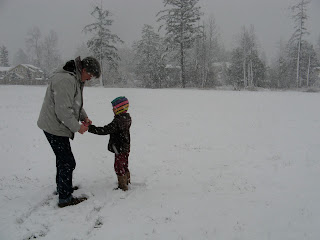As we move into winter, it is still important to get outdoors at least some of the time. Here, you see Alice getting some help fixing her gloves with her "papa" in the snow. There are all the typical fun things to do in the snow like build a snowman, have a snowball fight and make snow angels, but even these super fun activities can get pretty old quickly. I know getting outdoors everyday might be asking too much for a time of year when the days are short and darkness comes early, preparing for the cold makes it take longer to get ready for the outdoors and there is more to "clean up" when you come back in. In addition, you are busy with holiday baking and other preparations, but it is so worth it when you consider the positive impact the outdoors will have on the mood of your kids and yourself.
Most of us in the Western States particularly enjoy the thrill of downhill skiing and snow boarding, but cross country skiing is a great replacement to hiking this time of year. There is host of choices when it comes to winter sports to try if you have the means and time for a vacation together but I'm talking about quick activities you can do right at home (assuming it is cold enough outside).
Here are some other things you can try:
- Build a snow fort or Igloo. This is a great trial and error lesson in building and engineering if you have enough snow to do it. Take photos and record your efforts each day you try together. Once inside, put together a "journal" like a good scientist would recording what worked and what didn't. There is a Curious George episode you can watch together for the very young. This is only a portion of the actual episode, but I'm pretty sure you can borrow the episodes from Netflix or maybe it'll even be showing soon. You might also try hulu.
- If the roads are safe, drive to a wooded area and take cover from the wind and chill in the trees while you read, "Stopping by Woods on a Snowy Evening". Sit quietly and just listen to the winter woods for a few minutes. Instruct your children to really think about what they hear and see. Then, while you drive home, ask them to write a story, poem or description about what the woods are like in the quiet of winter.
- Go on a footprint walk. Even though many animals migrate or hibernate through the winter, there are still plenty around and on the move foraging this time of year as well. Find an area where you can go for a short easy hike and find as many footprints as you can while you walk (snowshoe, or ski) the area. sketch the shapes of the footprints, or if you can, photograph the footprints (pretty tough to do, but possible if the light is just right).
- Look up A Guide to Nature in Winter by Donald Stokes - This is an old book now, but its a good one for learning about how to do nature observations in winter and getting fresh ideas for things you can look for. Look for wasp or midge "apartments" on dried goldenrod stems sticking out above the snow. Draw twigs and branches you see while you are outdoors with your kids. Go bird watching. Learn which birds are still in the area, put out a little seed for them and then sit very still and wait for them to come. Identify those that you see. . .
- From the cozy indoors, sit near the biggest window in your space and have the kids do some free writing about how winter makes them feel. For older kids, ask them to go back through the free writing that was completed and incorporate some of those feelings into a poem that uses winter symbols metaphorically to illustrate their feelings about winter.
- Have your kids spend ten minutes outside looking for 5 "winter symbols" they can sketch quickly. When they come in, they can turn their sketches into drawings while sipping on some cocoa - to make the cocoa really special, drop a peppermint stick in it.
- Go people watching. Find a somewhat sheltered park bench or place to sit in a public space. Draw people passing buy in their winter wear or looking into a shop window decorated for the holidays, describe the people you see to illuminate mood. Do the people shuffle or do they glide? Are they hunched over and looking down, or are the briskly walking along erect and smiling?
- Spend at 4-6 consecutive weeks one day/week noting when the sun rose, when it set and how high in the sky it appeared at noon.
- Go out at least one evening after dark during the full moon and draw the winter you see as it looks lit in silver instead of gold.
- Decorate an outdoor tree (even if it is a small palm tree). You can make snowflakes out of foil or use outdoor lights and decor you already own (or both) if you are worried about sentimental decorations being ruined in the weather. You don't have to decorate for Christmas either. Hanukkah and Kwanzaa both also occur in December. Use decor that matches your family's religion's nearest holiday in time. For example, blue and gold decor with menorahs will work well for Hanukkah or green and red candle decorations for Kwanzaa. Hindu? hang lights to celebrate Diwali and put up a laminated sign about the holiday for non-Hindi neighbors.

No comments:
Post a Comment
Thanks for your comments!